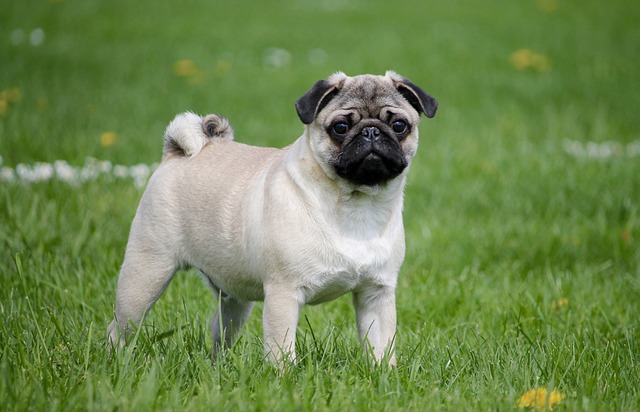


The Pug is a small, sturdy, and affectionate dog known for its wrinkled face, curled tail, and friendly personality. Despite their small size, Pugs have a big, bold personality and are often described as being comical and charming. They are known for being excellent companions, forming strong bonds with their families. Pugs are easygoing and adaptable, making them a great choice for a wide variety of households, from city apartments to suburban homes. They are friendly with children and other pets, and their playful, loving nature makes them one of the most popular companion breeds in the world.
The Pug is an ancient breed, believed to have originated in China over 2,000 years ago. They were bred to be companion dogs for Chinese emperors and were highly prized by royalty. The breed made its way to Europe in the 16th century, where it gained popularity among the nobility, especially in the Netherlands and England. Pugs became particularly famous in the courts of European monarchs, including Queen Victoria of England, who was a known fan of the breed. The breed’s charming personality and distinctive appearance helped solidify its place as a beloved companion dog. Today, the Pug is a popular pet around the world, known for its affectionate and playful nature.
The Pug is a small dog with a compact, sturdy build. They typically stand about 10 to 14 inches tall at the shoulder and weigh between 14 to 18 pounds. Pugs have a distinctive round head with deep wrinkles on their face, which gives them their characteristic "wrinkled" expression. Their eyes are large, dark, and expressive, often described as "begging" eyes. Pugs have a short, smooth coat that comes in a variety of colors, including fawn, black, and silver. They are known for their tightly curled tail, which adds to their charming appearance. While their compact size makes them a suitable choice for apartment living, they do require proper care to maintain their health, particularly due to their brachycephalic (short-nosed) structure, which can lead to breathing issues.
Pugs are friendly, affectionate, and playful dogs. They are often described as "clowns" due to their humorous and charming nature. Pugs love being around people and are known for forming strong bonds with their families. They are particularly good with children and tend to get along well with other pets, including dogs and cats. Their social and loving temperament makes them excellent companions, and they often crave human attention. Pugs are known for their playful, lively behavior, but they are also quite content to relax and cuddle with their owners. While they can be independent at times, they are generally eager to please and enjoy being involved in family activities. Their affectionate nature often leads them to seek attention and affection from their owners, and they can sometimes become needy if left alone for too long.
Pugs are relatively low-energy dogs and do not require intense exercise. However, they do benefit from regular daily walks and playtime to stay healthy and avoid becoming overweight. While Pugs are playful, they are not as high-energy as some other breeds, and they are content with moderate physical activity. Short walks, interactive play sessions, and some indoor activities are usually enough to keep them stimulated. Pugs can overheat easily due to their brachycephalic structure (short snout), so it is important to avoid vigorous exercise in hot weather and to provide plenty of fresh water during physical activity. Regular exercise helps maintain their weight and keeps them fit, but care should be taken not to overexert them, especially in warm conditions.
Pugs are intelligent and eager to please, making them generally easy to train. However, their independent and sometimes stubborn nature can pose challenges, so consistent, positive reinforcement training is recommended. Pugs respond well to treats, praise, and play as rewards, and they tend to enjoy training sessions if they are kept short and fun. Early socialization is essential to ensure that Pugs are well-adjusted and comfortable around people, other pets, and new environments. They tend to be friendly with strangers and usually do not exhibit aggression toward other animals. Proper socialization helps Pugs develop into well-rounded dogs that are confident and adaptable. While they are generally friendly, Pugs can be a bit headstrong and will benefit from a patient, firm, and gentle approach to training.
The Pug is generally a healthy breed, but they are prone to certain health conditions due to their brachycephalic structure, including breathing problems, dental issues, and eye conditions. Pugs may suffer from brachycephalic obstructive airway syndrome (BOAS), which can cause difficulty breathing, especially in hot or humid weather. It’s important to monitor their breathing and ensure they do not overheat. They are also at risk for obesity, so it is important to feed them a balanced diet and provide regular exercise to maintain a healthy weight. Regular grooming is required to keep their short coat clean and healthy, and attention must be paid to their wrinkles to avoid skin infections. Cleaning their ears, eyes, and wrinkles regularly is an important part of Pug care. Regular veterinary check-ups are essential to monitor their health, especially as they age.
The average lifespan of a Pug is 12 to 15 years. With proper care, including regular veterinary visits, a balanced diet, and moderate exercise, many Pugs live to enjoy their senior years in good health. Like many small breeds, they tend to have a longer lifespan than larger dogs, but they can be prone to age-related issues such as arthritis, eye problems, and respiratory issues. Regular health check-ups and a good diet are important to help Pugs live long, happy lives. As they age, they may also develop health problems such as cataracts or hip dysplasia, so monitoring their health closely is key to ensuring their well-being throughout their lifespan.
© copyright Dog Compendium 2024 - 2025